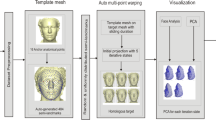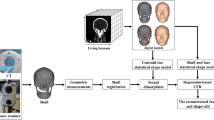Abstract
Craniofacial reconstruction is one of the dominating research domains having vital significance towards forensic purposes as well as archaeological investigation needs. With a goal to enable an error-resilient and swift craniofacial reconstruction model, in this paper an evolutionary computing assisted enhanced regression model has been proposed. We have developed an enhanced over-fitting resilient regression model called Ridge Regression (RR) as a statistical method to perform craniofacial reconstruction using landmark points and skull-face/(tissue) skin features. Our proposed model incorporates a hybrid evolutionary computing scheme containing Particle Swarm Optimization (PSO) and Differential Evolution (DE) to perform feature point selection and landmark count reduction. Here, the prime objective is to reduce the feature sets and landmark that can eventually make craniofacial reduction process more time efficient and accurate. The performance assessment reveals that the proposed PSO-DEFS based RRM model outperforms existing approaches such as the least square support vector regression (LSSVR) and partial least square regression (PLSR).









Similar content being viewed by others
References
Berar M, Desvignes M, Bailly G, Panyan Y (2005) 3d statistical facial reconstruction. Proceedings of the 4th International Symposium on Image and Signal Processing and Analysis. pp 365–370
Berar M, Tilotta FM, Glaunes JA, Rozenholc Y (2011) Craniofacial reconstruction as a prediction problem using a latent root regression model. Forensic Sci Int 210(1–3):228–236
Claes P (2007) A robust statistical surface registration framework using implicit function representations: application in craniofacial reconstruction. In Faculteitingenieurswetenschappen, department Elektrotechniek, afdeling PSI, K.U. Leuven, Leuven
Claes P, Vandermeulen D, De Greef S, Willems G, Suetens P (2006) Statistically deformable face models for cranio-facial reconstruction. J Comput Inf Technol 14(1):21–30
Claes P, Vandermeulen D, De Greef S, Willems G, Suetens P (2006) Craniofacial reconstruction using a combined statistical model of face shape and soft tissue-depths: methodology and validation. Forensic Sci Int 159(1):147–158
Claes P, Vandermeulen D, De Greef S, Willems G, Clement JG et al (2010) Computerized craniofacial reconstruction: conceptual framework and review. Forensic Sci Int 201(1):138–145
Claes P, Vandermeulen D, De Greef S, Willems G, Clement JG, Suetens P (2010) Bayesian estimation of optimal craniofacial reconstructions. Forensic Sci Int 201:146–152
De Greef S, Claes P, Mollemans W, Loubele M, Vandermeulen D, Suetens P, Willems G (2005) Semi-automated ultrasound facial soft tissue depth registration: method and validation. J Forensic Sci 50(6):JFS2004547–7
Deng Q, Zhou M, Shui W, Wu Z, Ji Y, Bai R (2011) A novel skull registration based on global and local deformations for craniofacial reconstruction. Forensic Sci Int 208:95–102
Duan S, Yang D, Huang Y, Hu ZW (2014) Craniofacial reconstruction based on multilinear subspace analysis. Multimedia Tools Appl 73(2):809–823
Hoerl A, Kennard R (1970) Ridge regression: biased estimation for nonorthogonal problems. Am Stat Assoc 12(1):55–67
Hu Y, Zhou M, Wu Z (2009) An automatic dense point registration method for 3d face animation. In: Image and Signal Processing, 2009. CISP'09. 2nd International Congress on IEEE. 2009, pp 1–6
Huang D, Duan F, Deng Q, Wu Z, Zhou M (2011) Face reconstruction from skull based on partial least squares regression. In: Computational Intelligence and Security (CIS), 2011 SeventhInternational Conference on IEEE. 2011, pp 1118–1121
Li Y, Chang L, Qiao X, Liu R, Duan F (2014) Craniofacial reconstruction based on least square support vector regression. SMC pp 1147–1151
Lorensen WE, Harvey EC (1987) Marching cubes: a high resolution 3D surface construction algorithm. ACM Siggraph Comput Graph 21(4):163–169
Paysan P, Luthi M, Albrecht T, Lerch A, Amberg B, et al. (2009) Face reconstruction from skull shapes and physical attributes. Pattern Recognition. Springer Berlin Heidelberg, pp. 232–241
Roozbeh M (2016) Robust ridge estimator in restricted semiparametric regression models. J Multivar Anal 147:127–144
Tilotta F, Richard F, Glaunes JA, Berar M, Gey S, Verdeille S, Rozenholc Y, Gaudy JF (2009) Construction and analysis of a head CT-scan database for craniofacial reconstruction. Forensic Sci Int 191(1):112–e1
Turner WD, Brown RE, Kelliher TP, Tu PH, Taister MA, KWP M (2005) A novel method of automated skull registration for forensic facial approximation. Forensic Sci Int 154:149–158
Vigneau E, Qannari M (2002) A new algorithm for latent root regression analysis. Comput Stat Data Anal 41:231–242
Wilkinson C (2004) Forensic facial reconstruction. Cambridge University Press, Cambridge
Author information
Authors and Affiliations
Corresponding author
Rights and permissions
About this article
Cite this article
Mansour, R.F. Evolutionary computing enriched ridge regression model for craniofacial reconstruction. Multimed Tools Appl 79, 22065–22082 (2020). https://doi.org/10.1007/s11042-017-5015-0
Received:
Revised:
Accepted:
Published:
Issue Date:
DOI: https://doi.org/10.1007/s11042-017-5015-0




